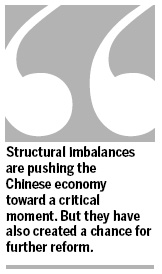BizViews
Temper govt ties with economy
(China Daily)
Updated: 2010-03-02 14:22
 |
Large Medium Small |
Policies that induce private investment and don't favor producers are key to sustained growth in the future
The essence of the so-called China model - if the Chinese experience can be labeled a model in the first place - rests on four requirements: social equality, a strong and effective bureaucracy, pragmatism and a disinterested government. These maxims have a lot to offer other developing countries and challenge the wisdom on state governance and methods of reaching economic growth.
Social equality is a result of revolutions in the twentieth century. It helps China avoid the politics of strong interest groups and elitism that plague many other developing countries. A strong and effective bureaucracy is both an historical heritage and a result of the current government led by the Communist Party, which has strong organizational capabilities. Pragmatism allows China to adopt imperfect but working solutions that answer the most urgent issues at the time.

Western countries often try to impose the first solutions on developing countries, but the results are usually unsatisfactory. China has adopted market institutions at its own pace but has made significant progress in a relatively short period of time.
Finally, a disinterested government is a government that is neutral to the conflict of interests among social groups. The Chinese government has acted in a disinterested way that allows it to concentrate on long-term economic growth instead of being swayed by short-term or biased interests.
Many observers believe the core of the China model is authoritarianism. Although there are elements of authoritarianism in China, people are generally confusing authoritarianism with meritocracy - a hierarchical system that rewards individual performance and embraces the culture of elitism - which has helped China to align the interests of government officials with the broad interests of society.
Meritocracy should not be compared equally with authoritarianism. Some elements of meritocracy - such as a relatively autonomous bureaucracy and a system of rewards for government officials - have universal values, especially as a counterbalancing force against extreme populism in some democracies.
But upon closer examination, one will find that the authoritarian aspect of China's development, especially the government's heavy involvement in the economy, does more harm than good to China's economic growth. True, China's rapid recovery from the financial crisis owes a great deal to strong government initiatives, but government investments has crowded out private investments, creating the possible accumulation of new nonperforming loans. In the long run, direct government involvement in the economy is fraught with more serious problems.
One of the issues is that government intervention will aggravate China's economic structural imbalance, which is mostly due to a drop in spending and labor incomes. The causes of the problem are complicated, but a heavy government hand in the economy definitely is one of them.
To attract investors, local governments provide them with a number of kickbacks, such as reduced taxes, land that is nearly free of cost, subsidized loans, and a hands-off approach on labor and environmental rules. Government policies are heavily in favor of producers. In return, investors are required to sink their money into high value-added projects that also happen to be capital intensive. But China's comparative advantage is still in labor-intensive industries. According to the 2004 national economic census, capital intensity was 500,300 yuan ($73,285) per worker in domestic companies, whereas the figure was 314,000 yuan per worker in foreign-invested firms, most of which come to China to take advantage of the nation's abundance of labor.
| ||||
While government investment is generally a blessing for China, and an envy of countries stranded by excessive redistribution, a large fraction of it is wasteful.
Lastly, heavy government involvement opens the door for interest groups. A heavy emphasis on economic growth is pushing local governments to self-commercialization, which in turn pushes them to form alliances with business interests. This would change China's landscape of equal social structure, one of the foundations for its rapid growth, if it were allowed to continue.
Therefore, even if it exists, the so-called China model needs to be reformed. At its core, reform must denationalize the economy and induce more political participation from citizens. The first is aimed to neutralize the government in its handling of the economy so that its policies are less in favor of producers. The second is to restore the role of government budgets to serve the welfare of the people. Reforms in the last three decades have been mostly responses to crises or acute problems. Structural imbalances are pushing the Chinese economy toward a critical moment. But they have also created a chance for further reform.
The author is professor and director, China Center for Economic Research, Peking University.













